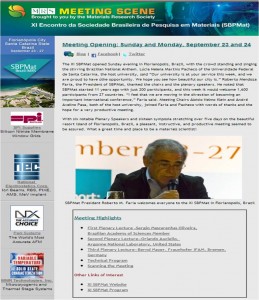The scientific paper by members of the Brazilian community in Materials research featured this month is:
Josue Ortiz-Medina, M. Luisa García-Betancourt, Xiaoting Jia, Rafael Martínez-Gordillo, Miguel A. Pelagio-Flores, David Swanson, Ana Laura Elías, Humberto R. Gutiérrez, Eduardo Gracia-Espino, Vincent Meunier, Jonathan Owens, Bobby G. Sumpter, Eduardo Cruz-Silva, Fernando J. Rodríguez-Macías, Florentino López-Urías, Emilio Muñoz-Sandoval, Mildred S. Dresselhaus, Humberto Terrones, Mauricio Terrones. Nitrogen-Doped Graphitic Nanoribbons: Synthesis, Characterization and Transport. Advanced Functional Materials 2013, 23, 3755-3762. DOI 10.1002/adfm.201202947.
Changing the properties and morphology of graphene nanoribbons with nitrogen
Multiple layers of graphene with the shape of ribbons (narrow and long) are called graphitic nanoribbons. These materials have been studied to control their properties by various methods, such as doping, in which are introduced atoms of “foreign” elements in the graphene carbon lattice.
In a study led by scientists at Pennsylvania State University with the participation of researchers from institutions in the United States, Mexico, Spain and Brazil, nitrogen-doped graphitic nanoribbons were manufactured by the chemical vapor deposition (CVD) method and showed new features, linked with the introduction of nitrogen, such as highest semiconductor performance, promising for applications in electronic devices, chemical reactivity and a very particular morphology on its edges. The research was published in the journal Advanced Functional Materials.
“This article showed by the first time that it is possible to make doping with nitrogen on the same synthesis by CVD of graphite nanoribbons, and that you can control the level of doping during synthesis,” highlights Fernando Rodríguez-Macías, foreign visiting professor at the Brazilian Federal University of Pernambuco (UFPE) and one of the authors of the scientific paper. A Mexican national, Rodríguez-Macías came to UFPE in 2012, during his sabbatical year to work as a foreign visiting professor in the Department of Fundamental Chemistry and in the Graduate Program in Materials Science of the University. “I have prolonged my stay for another year to continue until 2014 doing collaborative studies for the production of carbon nanostructures, of bionanotechnology and toxicity of nanomaterials,” says the professor. “I am also teaching preparation and characterization of materials,” he adds.
The doped nanoribbons
The article’s authors showed that different concentrations of nitrogen generate controlled changes in material behavior. In particular, scientists have proven that the more nitrogen introduced into the structure of graphene, the most predominant the semiconductor behavior of nanoribbons. As an explanation to this phenomenon, the researchers suggested, based on theoretical calculations, that nitrogen atoms of doped nanoribbons act as scattering centers of electrons and decrease the conductive behavior of undoped graphene. “The control of doping level allows you to change the electrical properties of the nanoribbons, which can be useful for applications in transistors and other electronic devices,” says Rodríguez-Macías.
In addition, the paper also shows that the reactivity of nanoribbons can change with the doping level. Pure graphene, explains UFPE’s visiting professor, is very inert and has limited interactions with many chemical substances; on the other hand, nanoribbons doped with nitrogen are more reactive, which makes them useful for applications in sensors and catalysis.
As to the morphology, the article’s authors found that the nitrogen-doped nanoribbons have loops on their edges, uniting different graphene sheets. “This morphology is not presented by undoped graphite nanoribbons,” says Rodríguez-Macías.

This figure, sent by Professor Fernando Rodríguez-Macías, shows the nitrogen-doped graphitic nanoribbons in three scales. The scanning electron microscopy (top left corner) shows how these ribbons are made up of several layers and feature a curved surface with roughness. The transmission electronic microscopy (bottom left corner) shows that the nanoribbon layers are graphene sheets. The high resolution transmission electronic microscopy (right) shows that the layers of graphene on the nanoribbons edges form loops uniting different graphene sheets.
Collaborators
Almost all work of materials synthesis of the paper of Advanced Functional Materials was developed at Pennsylvania State University; the characterization was done in collaboration with other researchers and laboratories, reports UFPE’s visiting professor.
The participation of UFPE in the article happened through the doctoral student Miguel Angel Pelagio-Flores in the analysis and theoretical modeling of doped nanoribbons, and through professor Fernández-Macías himself, who, in addition to having participated in the discussion of results and review of the article from his office at UFPE, was doctoral advisor of the first author of the article, Josué Ortiz-Medina, while professor of a Mexican institution, IPICYT. “Ortiz-Medina did most of the experimental work of the article, besides being an important part of the characterization and theoretical studies of these new nanomaterials, when he was in exchange at Penn State in the laboratory of professor Terrones,” contextualizes the professor.
In total, 19 authors sign the article, among them MIT’s Professor Mildred Dresselhaus, reference in carbon science.



 A Materials Research Society (MRS), realizou uma cobertura do XI Encontro da SBPMat por meio de seu editor de notícias científicas, Tim Palucka, que esteve presente em nosso evento.
A Materials Research Society (MRS), realizou uma cobertura do XI Encontro da SBPMat por meio de seu editor de notícias científicas, Tim Palucka, que esteve presente em nosso evento.